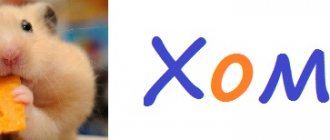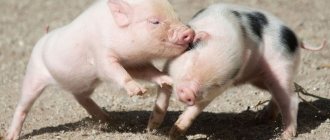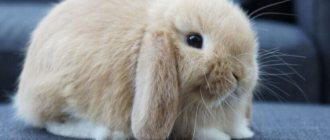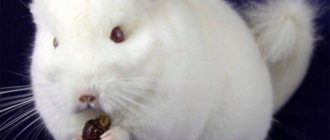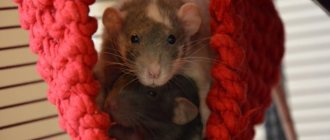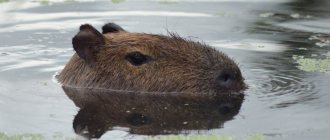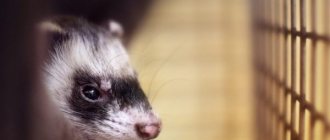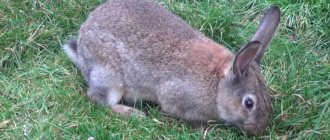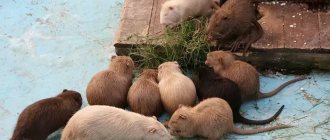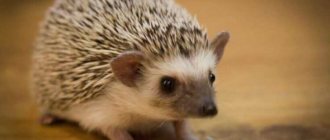Oddly enough, among all types of decorative rodents, domestic rats are becoming increasingly popular. These animals are very friendly, easy to care for, do not require much space to keep, and can always cheer you up. Moreover, it is believed that rats are very intelligent creatures, smart, cunning, and have a good memory.
There are a huge variety of rat breeds, which differ in size and type of fur. The main ones are presented in the photo below.
Varieties
There are several popular types and breeds of decorative rats:
- standard - a rat with smooth, glossy fur;
- Dambo - ears are larger than the others, rounded, low-set;
- satin - long wool, silky and shiny in appearance;
- sphinx - hair is completely absent;
- tailless - no tail;
- rex - much denser coat;
- double rex - hairless in some places, with rough fur in others;
- albino - a white decorative rat with red eyes.
Hairline
Many people mistakenly believe that rats have a tail without hair, but upon closer inspection and touch it becomes clear that the tail is covered with many small hairs. The tail is warm and slightly rough to the touch.
The rat's tail became this way due to the process of evolution. Rats are excellent swimmers; they often live near bodies of water, and it is their smooth tail that allows them to easily and comfortably stay in the water. If a rat's tail were fluffy, it would cause many problems and inconveniences.
Content Rules
Keeping decorative rats does not require any special wisdom. The main thing to do is to purchase a spacious cage.
Animals love to move, so they need space. The cage must be equipped:
- filler - the ideal option would be dry wood (it absorbs odors and liquids well);
- a house - a rat sometimes needs privacy;
- tunnels and ladders - pets will definitely want to play and run around;
- drinking bowl with fresh and clean water;
- a feeder well fixed to the rods;
- mineral stone so that animals can chew it.
It is strictly forbidden to use litter made from coniferous trees for decorative rats. It can cause serious illness and even death.
You can complement the design of the cage with various toys and treats for rodents.
Functions of the tail
Anatomically, a rat's tail is an extension of the spine. The shape of the tail resembles a cone - the middle part has small bones that are surrounded by tendons, which, in turn, are covered with skin. The tail along its entire length is penetrated with blood vessels.
The rat's tail performs two very important functions - balancing and thermoregulation.
- Balancing - thanks to the presence of a long tail, the rat can easily move along narrow vertical surfaces, such as a rope or wire. The tail controls balance, thereby allowing the rat to maintain balance. In addition, with the help of its tail, the animal can grab onto something, roll over onto its paws from its back and stand on its hind legs. The longer this process, the more dexterous and confident the rat’s actions.
- Thermoregulation - inside the tail, as mentioned above, there are many blood vessels. When a rat is hot, the blood vessels dilate, cooling the blood passing through them. Thanks to this process, the rodent's overall body temperature decreases. Conversely, when a rat experiences cold, the blood vessels constrict, causing blood to circulate more slowly, maintaining body temperature.
Important! In cases of real danger, the tail can shed its skin - this is a natural defense. The peeled skin remains with the enemy, giving the rat a chance to escape. Unfortunately, the rat's tail does not recover, like that of lizards, and in the future the animal has a not entirely attractive appearance.
Feeding
Do you want to know what to feed your kitty rat? Everything is quite simple, especially since pets are unpretentious in food.
Note!
- Domestic hedgehog - a review of the best hedgehog breeds to keep, all the features of the pet from feeding to living conditions! + photos and videos
Domestic goat - an overview of the features of keeping goats, how to care for them and what to feed them, as well as diseases, treatment and prevention of diseases in the review!
Sheep - learn everything about keeping sheep, features of living conditions, diet and the main characteristics of sheep as a pet!
The rat menu should consist of:
Grain. Experienced owners prepare and select the ingredients for feeding themselves. A ready-made mixture of grains can be purchased at almost any pet store.
Vegetables, herbs and fruits. In small quantities. There is no need for any special products here; common vegetables and fruits are quite suitable for rats. Herbs such as dill and parsley will also suit their taste.
Protein food. A little meat, cottage cheese or cheese. These products are not for your daily diet.
List of foods that should not be given to rodents: sweets, legumes, cabbage, sausage, soda and chips. Make sure your pet does not eat indoor plants, as this may be life-threatening.
How are the organs located inside the animal’s body?
The anatomy of the rat is well studied. The thoracic and abdominal regions of the animal are separated from each other by a diaphragm, under which a bright red liver is located. It partially obscures the pear-shaped stomach. To the left of the stomach is the oblong spleen.
Below these organs is a voluminous intestinal tract, covered with an omentum necessary for collecting animal fat. Behind the intestines, at the bottom of the abdominal cavity, there is a pair of bean-shaped kidneys. In rats they are asymmetrical - the left kidney is located deeper, as the stomach puts pressure on it.
The bladder is located in the lower abdomen of the animal. The ureters lead to it. In the same part of the body are the genital viscera:
- Males have testes;
- females have complex reproductive organs.
A peculiarity of the internal structure of rats is that they do not have a gallbladder. Bile flows from the liver through the duct directly into the duodenum.
The animal’s vascular system is the inferior vena cava, through which blood flows from the abdominal organs to the heart. The aorta runs nearby.
The heart, surrounded by large vessels, is located in the chest cavity. There is also a pair of pink lungs (the right one consists of four lobes, and the left one - of one). They are not attached to the chest, but hang freely on the bronchi. The esophagus is located deep in the sternum, playing the role of a connecting link between the stomach and pharynx.
Photos of decorative rats
Fun Features
If your rat is making a loud noise, he is likely unhappy. She may protest your treatment of her or show her displeasure at being taken out of her crate.
Night noise
Don't expect your rat to sleep on the same schedule as you. They are nocturnal, which means their normal sleep cycle is to play at night and sleep during the day.
Scavenger hunt
Rats take whatever they can get and then bring it back to their lair. They are especially prone to stealing items that they can chew, such as things made of wood, plastic, or rubber. Rats also hoard food; so don't be surprised to find a little edible stash hidden in your rat's cage.
Boxing
Rats do not box for fun or play. They box to show who is the alpha rat. They have a natural social hierarchy with the dominant rat emerging from the pack.
Bites
If your rat is chewing or licking you, it may be showing affection by grooming you. They also have a great sense of smell, so a rat may chew, lick your hand, or smell you after you have eaten or cooked food. Your pet may bite you if it finds leftover food, such as crumbs or sauce, on your hands.
Digging
In the wild, rats live in underground burrows. Pet rats will also dig burrows or the ground, especially if they are offered bedding or a pile of shredded paper, to create a safe and comfortable place to sleep.
wiggling mustache
We have GPS to get from point A to point B. Rats have whiskers which they use to navigate objects and also to maintain balance. The rodent moves its whiskers to literally get a better sense of its surroundings, such as to see whether an object is moving or static and to gather other spatial information.
Tail movements
If you suddenly grab your rat, he may flick his tail, trying to feel his way through what is happening. The rat also uses its tail for balance, which it holds straight while running. They even use their tail to support themselves in a standing position.
Bulging eyes
Eye bulging occurs when a rat's eyes move in and out of their sockets. Don't worry, the animal isn't completely crazy yet. In fact, the rat may be quite relaxed and happy at this point.
Teeth grinding
Protruding eyes usually occur along with teeth grinding, also called bruxism. Rats' teeth are constantly growing, so teeth grinding helps keep them under control. A rat is more likely to grind its teeth when it is relaxed and content, similar to how a cat purrs. The sounds made by her jaw moving back and forth and her teeth grinding create vibrations and cause the rat's eyes to bulge.
Types of breeds
First of all, it is worth understanding that each breed has its own individual characteristics. Animals of different breeds have different builds, sizes, fur and colors.
So, let's look at how they are distinguished:
- By body type. Dumbo and standard.
- By type of wool. Standard, hairless, wavy, downy, rex.
- By color. Single-color, combined, three-color, mosaic, silver, husky.
- Marking. The color base is predominantly white.
Lifestyle and nutritional specifics
Rats lead both group and solitary lifestyles. A large colony is capable of controlling an area of up to 2000 square meters. m, marking it and protecting it from the penetration of strangers. Within a group, which can contain 100 or more individuals, there are complex relationships built on a hierarchical principle.
Rat society is dominated by alpha males, endowed with large size and physical strength. Their behavior is characterized by independence and aggressiveness; they mate with females. The remaining males occupy a subordinate position. Relations between females are more peaceful, but among them there are also “privileged” individuals who make the main contribution to the rat population. Photos of wild rats will help you carefully examine and study the pests.
Rats are able to survive and even reproduce in extreme conditions when other animals die. The reproductive capacity of rodents is quite high. Under natural conditions, offspring are born mainly in the warm season, and in heated shelters, reproduction occurs all year round, the number of broods reaches 8.
Reproduction of rodents
In one litter there is an average of up to 10 cubs, the weight of which is in the range of 4-6 g. The rats are hairless, blind and their ear canals are closed. After a month they become independent. Stillborn and weakened rat pups are eaten by the mother, and the male is capable of destroying the entire litter.
18 hours after birth, the female gains the ability to mate. Pregnancy lasts approximately 24 days. The lifespan of rats depends on the species and ranges from 1.5 to 3 years, although rarely 95% of individuals survive to this age due to the high mortality of offspring, predators, cannibalism, as well as active human activity to destroy dangerous carriers of numerous infections.
Habitat and lifestyle greatly influence what wild rats eat. Animals are omnivores, and due to the fact that they are mammals, their bodies need animal proteins:
- the need for protein is satisfied by amphibians, mollusks and fish;
- rats catch small rodents, steal bird eggs and chicks from nests;
- Among plant foods, they prefer cereals, nuts, fruits and green plant matter.
Living close to people is a great privilege; in these conditions, rats feed on all available food. On average, an animal eats up to 25 g of food per day. Hunger is the worst enemy of rats; without food they die within 3-4 days, and without water even faster. The daily fluid intake is in the range of 30-35 ml.
Caring for dysocactus at home
Lighting for disocacti
“Rat tails” are today considered one of the most light-loving representatives of succulents. But unlike many other cacti, these ampelous beauties with climbing shoots do not tolerate direct sunlight very well. For dysocacti, it is necessary to provide bright, diffused lighting. Window sills of eastern and western orientation or southern windows with appropriate shading at noon are considered ideal for them.
Since the plant develops buds during winter, the lighting regime during this period is very important for it. For aporocacti, during the cold season, the lighting is increased by moving the containers to brighter places. If correction is not carried out, abundant flowering will not be achieved.
Bright lighting is also critical during warm winters
The vast majority of disocacti do not like artificial lighting and need a naturally bright location.
Comfortable temperature conditions
Unfortunately, magnificent dysocacti cannot be counted among those subspecies of the main indoor succulents that are able to bloom under any conditions. The easiest way to achieve flowering is to winterize it in a warm room. To produce flowers, “rat tails” need to be kept cool or carefully monitor the lighting and dramatically adjust their care.
During the period of active development, this not the most heat-loving cactus is best kept at a temperature of 20 to 25 degrees. Disocactus will tolerate hotter conditions only outdoors. But during the dormant period, it is better to provide aporocacti with a cool temperature of 7 to 10 degrees. Warmer wintering will lead to a reduction in the number of buds, and if the lighting is not corrected, there will be no flowering at all.
Unlike many cacti, disocactus can be taken out into the fresh air, placed on balconies and terraces (and even in the garden), provided it is protected from direct sunlight and precipitation.
Disocactus flagelliformis is better known as Aporocactus flagelliformis. Olgapro
Watering and air humidity
The intensity of watering for this cactus directly depends on the stage of development. Regular procedures will only be needed in spring and summer. In this case, as for all other representatives of the cactus family, it is necessary to carefully avoid any waterlogging and only keep the substrate slightly moist. Stagnation of water in the pan, too much and frequent watering can lead to the death of the plant. The following procedure is carried out only after the top layer of soil has completely dried and the substrate in the middle part of the pot has partially dried.
During the dormant stage, dysocacti require much more limited watering. Regardless of the temperature, the following procedure in winter should be carried out only when the substrate is completely dry. If disocacti are kept in cool conditions, then watering is carried out extremely rarely in accordance with the low rate of soil drying. When wintering in warm conditions, the cactus needs almost dry conditions.
In their preferences for air humidity, “rat tails” are somewhat different from their other counterparts. Disocactus does not need conditions of high humidity at all, but at the same time it really likes spraying during the summer if the air temperature rises above 24-25 degrees Celsius. Spraying is usually carried out with warm water, slightly moistening the plant. During autumn and winter, spraying is strictly prohibited.
Ackermann's disocactus (Disocactus ackermannii). John C.Disocactus biformis. Universität GöttingenDisocactus speciosus. Universität Göttingen
Fertilizers for disocacti
Fertilizers for this type of cacti are applied exclusively during the period of active development. Typically, plant fertilizers are added to irrigation water from March to mid-summer. The easiest way to navigate is by the timing of stopping fertilizing at the end of flowering. As soon as the cactus sheds its last flowers, you must stop applying fertilizer in any form. During the active period of development, special mixtures of fertilizers intended for representatives of the Cactus family are used for dysocacti. The optimal frequency of procedures is 1 feeding per month.
